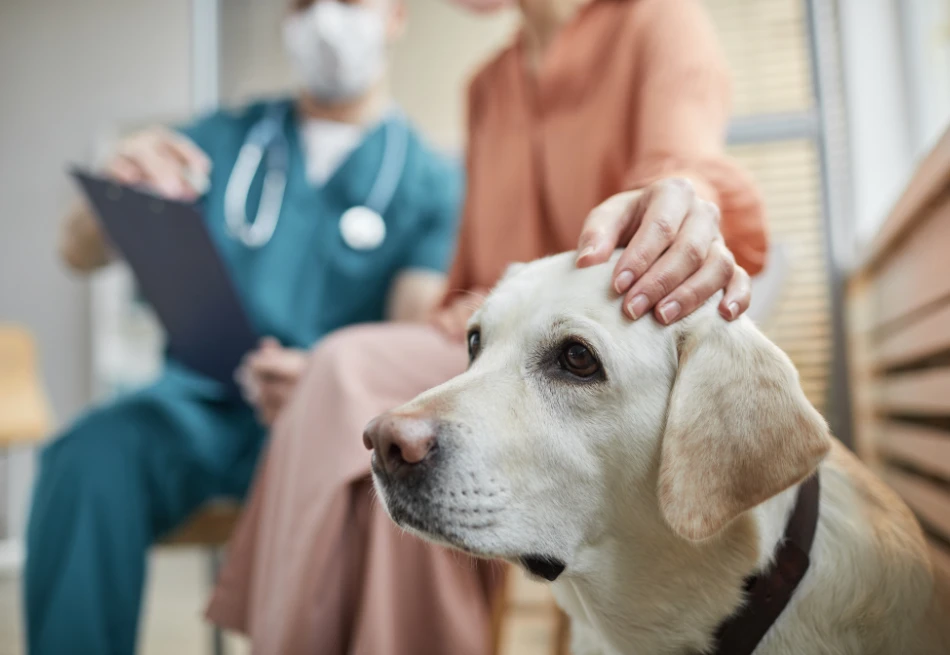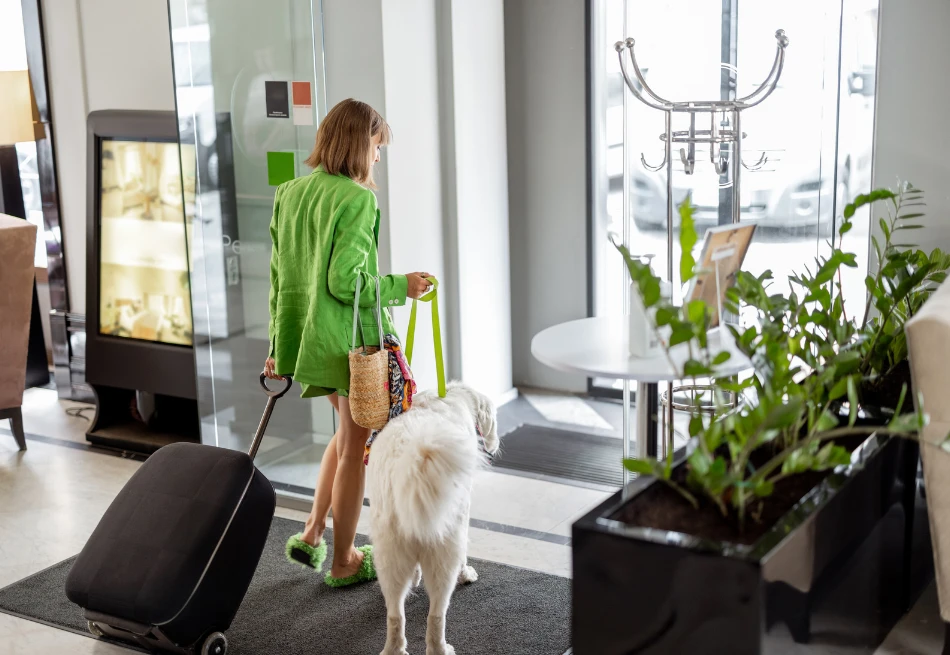Traveling with your dog can be an exciting adventure, but it takes careful planning to make the trip safe and pleasurable for both you and your furry buddy.
Preparation is vital, from making a vet appointment and ensuring immunizations are up to date to gradually acclimating your dog to travel circumstances.
Packing the necessary supplies, such as food, water, prescriptions, and comfort, can make a significant difference.
Understanding the intricacies of different means of transportation, such as vehicles, airlines, or trains, will assist you in negotiating laws and protecting your dog’s safety.
This comprehensive book will teach you everything you need to know to ensure a pleasant and pleasurable journey with your dog.
Preparation Before Traveling
Vet Check and Health Documentation

Before leaving on a trip, take your dog to the veterinarian for a complete inspection.
This visit is essential for ensuring your dog is healthy and capable of dealing with trip stress.
During the checkup, ensure that all vaccines are up to date.
Some destinations and airlines demand health certifications, so having these credentials readily available is necessary.
These documents may also be useful if you experience any health problems while traveling.
Comfort and Safety Training
To ease your dog’s fear and make the trip go more smoothly, gradually adapt them to the traveling environment.
If you intend to go by car, begin with brief drives about the neighborhood to acclimate your dog to the motion and surroundings.
Place food and toys inside to create a happy and comfortable environment for crate training.
By doing this, you can encourage your dog to associate the crate with good qualities.
Gradually extend your dog’s time in the crate so that they are completely at ease prior to the journey.
Making your dog feel secure requires consistency and positive reinforcement.
Packing Essentials for Your Dog
| Item | Description |
| Carrier or Crate | Sturdy and comfortable for safe travel. |
| Leash and Harness | Reliable for walks and outdoor activities. |
| Food and Water | Sufficient supply for the journey, along with portable bowls. |
| Bedding | Familiar bed or blanket for comfort. |
| Toys | To keep your dog entertained during the trip. |
| Medications | Prescribed medications and a first-aid kit. |
| Waste Bags | Enough for the duration of the trip to clean up after your dog. |
| Veterinary Records | Health certificate and vaccination records. |
| Identification | Collar with ID tag and microchip information. |
| Travel Documents | Airline or accommodation pet policies, booking confirmations. |
By keeping this checklist handy, you can ensure you have everything you need for a smooth and enjoyable trip with your dog.
Traveling by Car
If you want to keep your dog safe and avoid distractions while driving, use a crate, car seat, or dog seatbelt.
By doing this, you not only keep your dog safe but also reduce the possibility of mishaps by a wandering pet.
Dog safety equipment is made to keep pets safe during unexpected halts or crashes.
To ensure your dog is comfortable, make sure the automobile has adequate ventilation.
To reduce excessive heat and sunlight, use sunshades on your windows.
Since it can be risky and potentially fatal, never leave your dog alone in the car, especially during extremely high or low temperatures.
Make regular stops for restroom breaks and exercise.
This allows your dog to stretch, relieve itself, and remain calm.
Always keep your dog on a leash and ensure the spots you choose for these breaks are suitable and safe.
Keep your dog hydrated throughout the travel by providing water at each stop.
Dehydration can be a major problem, particularly in hot weather or long travels.
Use a travel-friendly water bottle with a bow attached, if possible.
Flying with Your Dog
Inquire about the airline’s pet rules, including any costs and restrictions about carrier size, with them.
Knowing the regulations of your airline before you book is crucial because they vary from one to the other.
Certain airlines permit the carriage of small dogs in the cabin, while others mandate that pets be shipped in the cargo hold.
Make sure all of your dog’s vaccines are up to date and get your dog checked up by a veterinarian.
If necessary, get a health certificate—certain airlines and destinations demand it.
This is especially crucial for overseas travel and places with stringent pet import regulations.
Book direct flights to reduce stress and prevent mistreatment during transfers.
Direct flights reduce the amount of time spent traveling and the likelihood of problems occurring.
If a direct flight is not possible, strive to reduce layover hours and ensure that layover airports have suitable facilities for your dog.
Ensure your dog is safe in the temperatures at the points of departure and arrival.
Plan your travel schedule to avoid the warmest or coldest times of the day, as extreme temperatures can be risky.
Check the airline’s temperature limits policy; some airlines have specific guidelines for pet travel during harsh weather conditions.
Traveling by Train or Bus
Train travel can be a relaxing and scenic choice for your dog if they meet the requirements and the trip is not too long.
Check the specific restrictions for size and carrier limitations.
Most interstate bus companies do not allow dogs, however, local routes may have varying policies.
Always check ahead of time to minimize surprises and verify that all regulations are followed.
If bus travel is required, consider hiring a pet transport company that specializes in safe and enjoyable pet travel.
Accommodation Tips

Look for pet-friendly hotels or vacation homes in advance.
Many lodgings include pet-specific policies and restrictions, such as size limits or additional costs.
Researching and arranging pet-friendly accommodations in advance helps guarantee a seamless stay.
Keep your dog’s quiet, pick up after them, and don’t let them alone in the room.
This ensures that the accommodation remains pet-friendly for future travelers.
Always bring your dog’s bed or blanket to provide them a familiar sleeping environment and help them relax in.
General Tips for a Smooth Journey
Identification and Safety
Make sure the ID tag on your dog’s collar has your contact information on it.
Consider microchipping your dog so they have permanent identification in case they become missing.
Put the phone numbers of neighboring veterinary facilities and your regular vet on your phone so you’re ready for any emergency.
Maintaining Routine
Try to maintain your dog’s regular routine for exercise and food.
This keeps them comfy and reduces stress.
Bring familiar items, such as their bed and toys, to help alleviate anxiety.
Consistency in their routine can help your dog adapt to unfamiliar settings more readily.
Frequently Asked Questions
Should I sedate my dog for air travel?
Since there could be health dangers, sedation is generally not advised when traveling by plane. Instead, ask your veterinarian about complementary therapies like anxiety wraps or natural medicines for anxiety management.
What should I do if my dog has a bathroom accident during travel?
Pack cleaning items like paper towels, disinfecting wipes, and trash bags. If your dog has an accident, clean it up right once to keep him healthy and comfortable.
Can I bring my dog’s regular food on an international trip?
Yes, but make sure to research the import laws of the country you’re visiting. Some countries have restrictions, so you may have to buy your dog’s food locally when you arrive.
What are the rules for service dogs on planes?
In general, service dogs are welcome in the cabin at no extra cost. They must be well-behaved and fit within the designated space. Check the airline’s regulations and documentation for assistance dogs.
What do I do if my dog needs medical attention while traveling?
Keep a list of the closest veterinary hospitals’ locations and their contact details handy. Keep track of your dog’s medical records and contact a veterinarian right away if it seems ill or injured.
Can I use public transportation with my dog?
Transportation modes and locations have different policies. Small dogs in carriers are welcome on many local buses and trains. Verify the particular rules governing the public transportation system you intend to utilize.
How can I manage my dog’s behavior in public places?
Leash your dog at all times and use treats to reward good behavior. To maintain control in public areas, practice simple instructions like sit, stay, and come.
What should I do if my dog refuses to eat while traveling?
Offer small, frequent meals and try to maintain their regular feeding schedule. If your dog continues to refuse food, consult a vet to rule out any underlying health issues.
What are some tips for road trips with multiple dogs?
Ensure each dog has a secure space in the car, either in separate crates or harnessed safely. Plan for frequent breaks, pack enough supplies for all dogs and manage their interactions to prevent stress or conflict.
